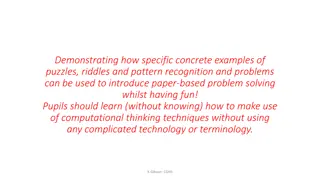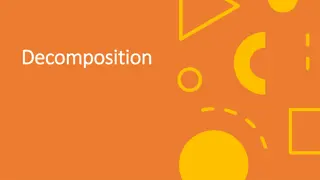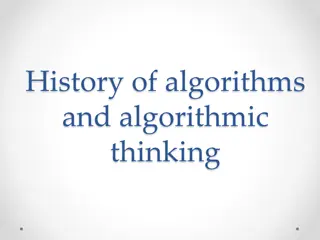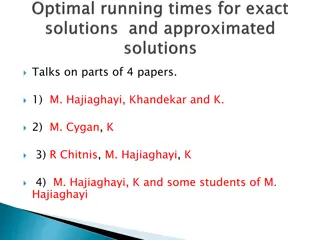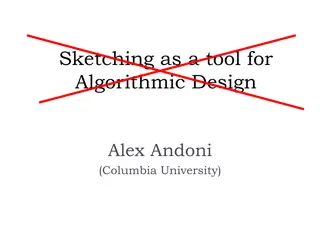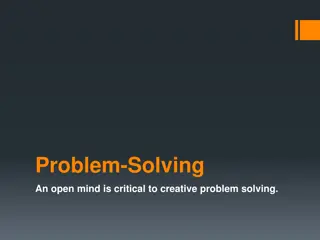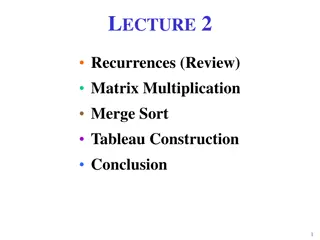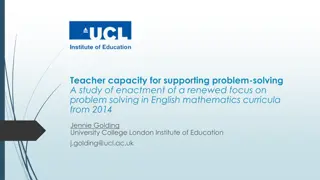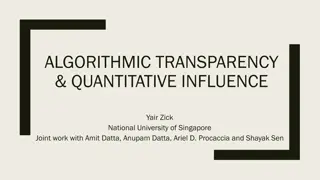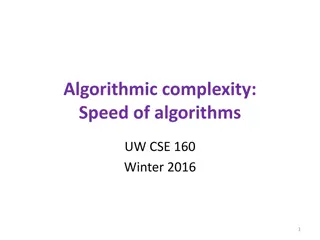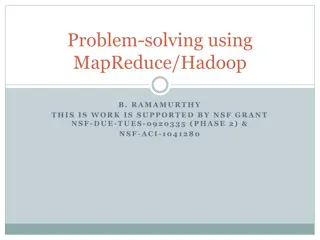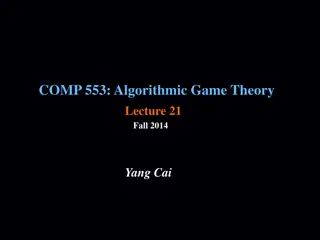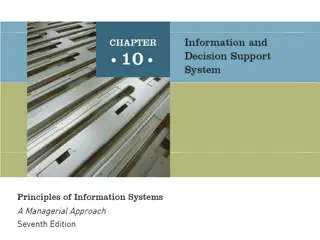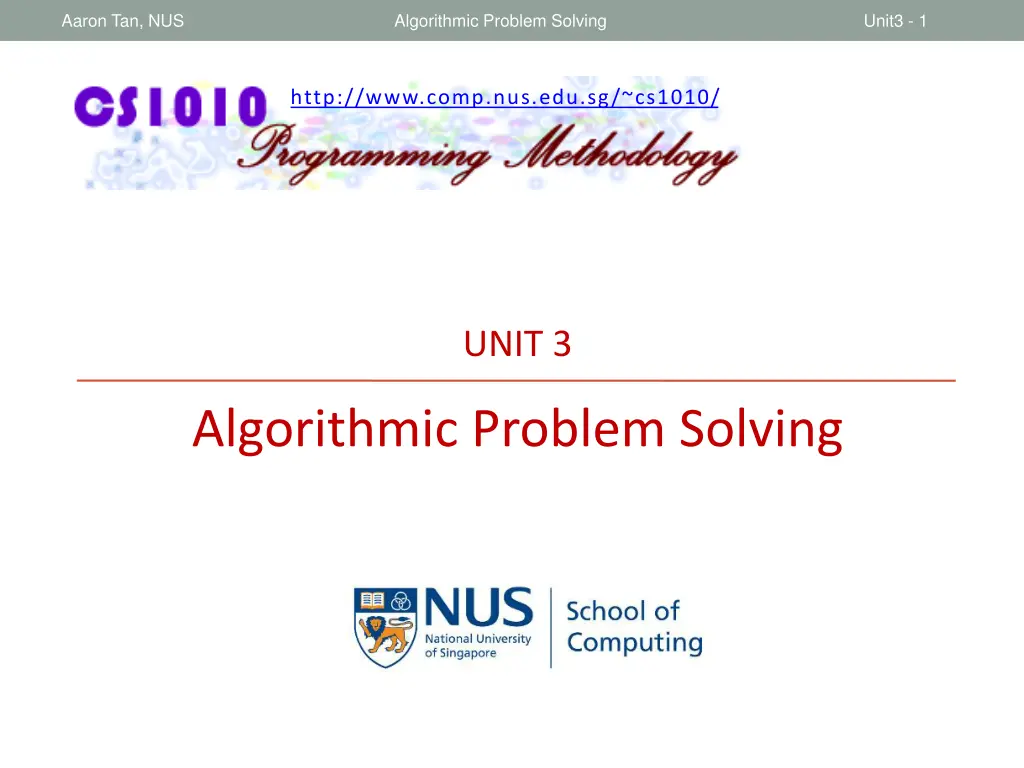
Algorithmic Problem Solving with Aaron Tan at NUS
Discover the world of Algorithmic Problem Solving with Aaron Tan at NUS through units focusing on topics like Computational Thinking, Euclid's Algorithm, Coin Change optimization problems, and the task-giver/task-solver contract. Explore historical algorithms, modern interpretations, and practical applications.
Download Presentation

Please find below an Image/Link to download the presentation.
The content on the website is provided AS IS for your information and personal use only. It may not be sold, licensed, or shared on other websites without obtaining consent from the author. If you encounter any issues during the download, it is possible that the publisher has removed the file from their server.
You are allowed to download the files provided on this website for personal or commercial use, subject to the condition that they are used lawfully. All files are the property of their respective owners.
The content on the website is provided AS IS for your information and personal use only. It may not be sold, licensed, or shared on other websites without obtaining consent from the author.
E N D
Presentation Transcript
Aaron Tan, NUS Algorithmic Problem Solving Unit3 - 1 http://www.comp.nus.edu.sg/~cs1010/ UNIT 3 Algorithmic Problem Solving
Aaron Tan, NUS Algorithmic Problem Solving Unit3 - 2 Unit Unit 3: Algorithmic Problem Solving 3: Algorithmic Problem Solving 1. Computational Thinking: Coin Change 2. Euclid s Algorithm 3. Algorithmic Problem Solving Process 4. Algorithm 5. Control Structures 6. Examples of Pseudocodes
Aaron Tan, NUS Coin Change Algorithmic Problem Solving Unit3 - 3 Problem statement Given the above coin denominations: 1 , 5 , 10 , 20 , 50 , and $1, assuming that you have unlimited supply of them, find the minimum number of coins needed for a given amount. This is called optimisation problem in CS finding the best among all possible solutions. Examples: 375 ? coins 543 ? coins Question you may ask: Do I need to report how many coins of each denomination in my solution? No, you don t have to. (But in the process of computing the solution you will somehow get to know how many coins of each denomination you need.)
Aaron Tan, NUS Contract of a Task Algorithmic Problem Solving Unit3 - 4 The Task Giver The Task Solver The amount (in ) The min. no. of coins The Task Giver: Provides the necessary inputs (arguments) to the Task Solver Does not provides unnecessary data to the Task Solver Does not care/need to know how the Task Solver solves the task The Task Solver: Accepts the necessary inputs (arguments) from the Task Giver Returns the result to the Task Giver Does not provides extraneous data to the Task Giver or perform extraneous work
Aaron Tan, NUS Euclid s Algorithm (1/3) Algorithmic Problem Solving Unit3 - 5 First historically documented algorithm by Greek mathematician Euclid in 300 B.C. Also known as Euclidean Algorithm q is not important; r is the one that matters. 1. Let A and B be integers with A > B 0. 2. If B = 0, then the GCD is A and algorithm ends. 3. Otherwise, find q and r such that A = q.B + r where 0 r < B r could be obtained by A modulo B (i.e. remainder of A / B) 4.Replace A by B, and B by r. Go to step 2. Assumption on A > B unnecessary We will rewrite the algorithm
Aaron Tan, NUS Euclid s Algorithm (2/3) Algorithmic Problem Solving Unit3 - 6 1. Let A and B be integers with A > B 0. 2. If B = 0, then the GCD is A and algorithm ends. 3. Otherwise, find q and r such that A = q.B + r Rewritten in modern form // Pre-cond: A and B are non-negative // integers, but not both zeroes. where 0 r < B 4.Replace A by B, and B by r. Go to step 2. Algorithm GCD( A, B ) { while (B > 0) { r A modulo B A B B r } return A } What the Task Giver must provide to this Task Solver Details of Task Solver unknown to Task Giver Pre-condition: What must be true for this Task Solver to work. What this Task Solver returns to the Task Giver.
Aaron Tan, NUS Euclid s Algorithm (3/3) Algorithmic Problem Solving Unit3 - 7 You might have guess what this algorithm does from its name but let s trace it with some examples. Very important skill! Let s trace GCD(12, 42) // Pre-cond: A and B are non-negative // integers, but not both zeroes. (B > 0)? r A 12 B 42 Algorithm GCD(A, B) { while (B > 0) { r A modulo B A B B r } return A } 12 true 42 12 6 0 true true false 12 6 6 0 So do you know what does the Euclid s Algorithm do now? Result returned: ?
Aaron Tan, NUS Polya s Problem Solving Process We (roughly)map Polya s steps to algorithmic problem solving. Algorithmic Problem Solving Unit3 - 8 1. Understand the Problem Analysis Iterative process 2. Make a Plan Design Implementation 3. Do the Plan Testing 4. Look back
Aaron Tan, NUS Algorithmic Problem Solving Algorithmic Problem Solving Unit3 - 9 Determine problem features Analysis Iterative process Design Write algorithm What is an algorithm? Implementation Write code Check for correctness and efficiency Testing
Aaron Tan, NUS Algorithmic Problem Solving Unit3 - 10 Algorithm (1/3) An algorithm is a well-defined computational procedure consisting of a set of instructions, that takes some value or set of values as input, and produces some value or set of values as output. Algorithm Input Output Algorithm stems from Algoritmi , the Latin form of al- Khw rizm , a Persian mathematician, astronomer and geographer. Source: http://en.wikipedia.org/wiki/Algorithm
Aaron Tan, NUS Algorithmic Problem Solving Unit3 - 11 Algorithm (2/3) An algorithm has these properties: The algorithm must terminate. (Or no solution will be obtained.) Each step must be exact. (Or it will not be precise.) Exact Terminate The algorithm must be effective. (i.e. it must solve the problem.) The algorithm must be general. (Within the constraints of the system/language.) Effective General
Aaron Tan, NUS Algorithmic Problem Solving Unit3 - 12 Algorithm (3/3) Ways of representing an algorithm: Flowchart Pseudocode lynda.com
Aaron Tan, NUS Algorithmic Problem Solving Unit3 - 13 Algorithm: Example #1
Aaron Tan, NUS Algorithmic Problem Solving Unit3 - 14 Algorithm: Example #2 (1/2) Find maximum and average of a list of numbers: Terminator box start Flowchart Process box sum count 0 max 0 Decision box end of input? Yes No Enter num increment count sum sum + num ave sum/count Yes print max, ave max num num > max? No end
Aaron Tan, NUS Algorithmic Problem Solving Unit3 - 15 Algorithm: Example #2 (2/2) Find maximum and average of a list of numbers: The need to initialise variables. Pseudocode sum count 0 // sum = sum of numbers // count = how many numbers are entered? max 0 // max to hold the largest value eventually for each num entered, count count + 1 sum sum + num if num > max then max num The need to indent. Are there any errors in this algorithm? ave sum / count print max, ave
Aaron Tan, NUS Algorithmic Problem Solving Unit3 - 16 Algorithm: Pseudocode We will write algorithms in pseudocode instead of flowchart as the former is more succinct However, unlike programming languages, there are no standard rules on how pseudocodes should look like General guidelines: Every step must be unambiguous, so that anybody is able to hand trace the pseudocode and follow the logic flow Use a combination of English (but keep it succinct) and commonly understood notations (such as for assignment in our previous example) Use indentation to show the control structures
Aaron Tan, NUS Algorithmic Problem Solving Unit3 - 17 Control Structures (1/2) An algorithm is a set of instructions, which are followed sequentially by default. However, sometimes we need to change the default sequential flow. We study 3 control structures.
Aaron Tan, NUS Algorithmic Problem Solving Unit3 - 18 Control Structures (2/2) Sequence Default True False Also called branching ? Selection Also called loop False Repetition ? True
Aaron Tan, NUS Algorithmic Problem Solving Unit3 - 19 Control Structures: Sequence (1/2) Task: Compute the average of three integers A possible algorithm: Variables used: num2 num1 num3 enter values for num1, num2, num3 ave ( num1 + num2 + num3 ) / 3 print ave ave Variables used: Another possible algorithm: num2 num1 num3 enter values for num1, num2, num3 total ( num1 + num2 + num3 ) ave total / 3 print ave total ave Each box represents a variable. Important concepts: Each variable has a unique name and contains a value.
Aaron Tan, NUS Algorithmic Problem Solving Unit3 - 20 Control Structures: Sequence (2/2) Task: Compute the average of three integers How the program might look like Unit3_prog1.c // This program computes the average of 3 integers #include <stdio.h> Don t worry about the C syntax; we will discuss it next week. For now, just to show you how the algorithm is translated into the code. The logic remains the same, but you need to write the code according to the rules of the programming language. int main(void) { int num1, num2, num3; float ave; printf("Enter 3 integers: "); scanf("%d %d %d", &num1, &num2, &num3); ave = (num1 + num2 + num3) / 3.0; printf("Average = %.2f\n", ave); } return 0;
Aaron Tan, NUS Algorithmic Problem Solving Unit3 - 21 Control Structures: Selection (1/3) True False ? Task: Arrange two integers in ascending order (sort) Algorithm A: enter values for num1, num2 // Assign smaller number into final1, // and larger number into final2 if (num1 < num2) then final1 num1 final2 num2 else final1 num2 final2 num1 // Transfer values in final1, final2 back to num1, num2 num1 final1 num2 final2 // Display sorted integers print num1, num2 Variables used: num2 num1 final1 final2
Aaron Tan, NUS Algorithmic Problem Solving Unit3 - 22 Control Structures: Selection (2/3) True False ? Task: Arrange two integers in ascending order (sort) Algorithm B: enter values for num1, num2 // Swap the values in the variables if necessary if (num2 < num1) then temp num1 num1 num2 num2 temp // Display sorted integers print num1, num2 Variables used: num2 num1 temp Compare Algorithm A with Algorithm B.
Aaron Tan, NUS Algorithmic Problem Solving Unit3 - 23 Control Structures: Selection (3/3) True False ? How the program might look like for Algorithm B Unit3_prog2.c // This program arranges 2 integers in ascending order #include <stdio.h> int main(void) { int num1, num2, temp; printf("Enter 2 integers: "); scanf("%d %d", &num1, &num2); if (num2 < num1) { temp = num1; num1 = num2; num2 = temp; } printf("Sorted: num1 = %d, num2 = %d\n", num1, num2); } return 0;
Aaron Tan, NUS Algorithmic Problem Solving Unit3 - 24 False Control Structures: Repetition (1/3) ? True Task: Find sum of positive integers up to n (assume n>0) Algorithm: enter value for n // Initialise a counter count to 1, and ans to 0 count 1 ans 0 while (count n) do ans ans + count count count + 1 // Display answer print ans Variables used: n count // add count to ans // increase count by 1 ans Initialisation is very important!
Aaron Tan, NUS Algorithmic Problem Solving Unit3 - 25 False Control Structures: Repetition (2/3) ? True Important to trace pseudocode to check its correctness Algorithm: enter value for n count 1 ans 0 while (count n) do ans ans + count count count + 1 // Display answer print ans Assume user enters 3 for n. (count <= n)? count ans 1 0 true 2 1 true 3 3 true 4 6 false Output: 6
Aaron Tan, NUS Algorithmic Problem Solving Unit3 - 26 False Control Structures: Repetition (3/3) ? True How the program might look like Unit3_prog3.c // Computes sum of positive integers up to n #include <stdio.h> int main(void) { int n; // upper limit int count = 1, ans = 0; // initialisation printf("Enter n: "); scanf("%d", &n); while (count <= n) { ans += count; count++; } printf("Sum = %d\n", ans); } return 0;
Aaron Tan, NUS Coin Change Algorithmic Problem Solving Unit3 - 27 Problem statement Given the above coin denominations: 1 , 5 , 10 , 20 , 50 , and $1, assuming that you have unlimited supply of them, find the minimum number of coins needed for a given amount. Can you write out the pseudocode of your algorithm? What must the Task Giver send to the Task Solver? What must the Task Solver return to the Task Giver? Algorithm CoinChange(amt) { . . . return coins }
Aaron Tan, NUS Algorithmic Problem Solving Unit3 - 28 Knowing the algorithmic problem solving process Knowing the properties of an algorithm Knowing the three control structures Knowing how to write algorithms in pseudocode Knowing how to trace algorithms to verify their correctness
Aaron Tan, NUS Algorithmic Problem Solving Unit3 - 29 End of File


